
The Red Spider Nebula is a planetary nebula located near the heart of the Milky Way, in the northwest of the constellation Sagittarius. The nebula has a prominent two-lobed shape, possibly due to a binary companion or magnetic fields and has an S-shaped symmetry of the lobes – the lobes opposite each other appear similar. This is believed to be due to the presence of a companion to the central white dwarf. However, the gas walls of the two lobed structures are not at all smooth, but rather are rippled in a complex way.

The Eagle Nebula is a young open cluster of stars in the constellation Serpens, discovered by Jean-Philippe de Cheseaux in 1745–46. Both the "Eagle" and the "Star Queen" refer to visual impressions of the dark silhouette near the center of the nebula, an area made famous as the "Pillars of Creation" imaged by the Hubble Space Telescope. The nebula contains several active star-forming gas and dust regions, including the aforementioned Pillars of Creation. The Eagle Nebula lies in the Sagittarius Arm of the Milky Way.

The Calabash Nebula, also known as the Rotten Egg Nebula or by its technical name OH 231.84 +4.22, is a protoplanetary nebula (PPN) 1.4 light years long and located some 5,000 light years from Earth in the constellation Puppis. The name "Calabash Nebula" was first proposed in 1989 in an early paper on its expected nebular dynamics, based on the nebula's appearance. The Calabash is almost certainly a member of the open cluster Messier 46, as it has the same distance, radial velocity, and proper motion. The central star is QX Puppis, a binary composed of a very cool Mira variable and an A-type main-sequence star.

The Eskimo Nebula, also known as the Clown-faced Nebula, Lion Nebula, or Caldwell 39, is a bipolar double-shell planetary nebula (PN). It was discovered by astronomer William Herschel in 1787. The formation resembles a person's head surrounded by a parka hood. It is surrounded by gas that composed the outer layers of a Sun-like star. The visible inner filaments are ejected by a strong wind of particles from the central star. The outer disk contains unusual, light-year-long filaments.

Minkowski 2-9, abbreviated M2-9 is a planetary nebula that was discovered by Rudolph Minkowski in 1947. It is located about 2,100 light-years away from Earth in the direction of the constellation Ophiuchus. This bipolar nebula takes the peculiar form of twin lobes of material that emanate from a central star. Astronomers have dubbed this object as the Twin Jet Nebula because of the jets believed to cause the shape of the lobes. Its form also resembles the wings of a butterfly. The nebula was imaged by the Hubble Space Telescope in the 1990s.
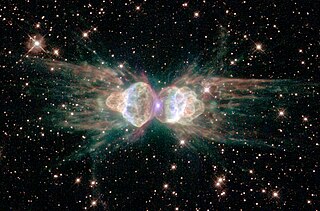
Mz 3 is a young bipolar planetary nebula (PN) in the constellation Norma that is composed of a bright core and four distinct high-velocity outflows that have been named lobes, columns, rays, and chakram. These nebulosities are described as: two spherical bipolar lobes, two outer large filamentary hour-glass shaped columns, two cone shaped rays, and a planar radially expanding, elliptically shaped chakram. Mz 3 is a complex system composed of three nested pairs of bipolar lobes and an equatorial ellipse. Its lobes all share the same axis of symmetry but each have very different morphologies and opening angles. It is an unusual PN in that it is believed, by some researchers, to contain a symbiotic binary at its center. One study suggests that the dense nebular gas at its center may have originated from a source different from that of its extended lobes. The working model to explain this hypothesizes that this PN is composed of a giant companion that caused a central dense gas region to form, and a white dwarf that provides ionizing photons for the PN.

Astronomy Picture of the Day (APOD) is a website provided by NASA and Michigan Technological University (MTU). It reads: "Each day a different image or photograph of our universe is featured, along with a brief explanation written by a professional astronomer." The photograph does not necessarily correspond to a celestial event on the exact day that it is displayed, and images are sometimes repeated. These often relate to current events in astronomy and space exploration. The text has several hyperlinks to more pictures and websites for more information. The images are either visible spectrum photographs, images taken at non-visible wavelengths and displayed in false color, video footage, animations, artist's conceptions, or micrographs that relate to space or cosmology.
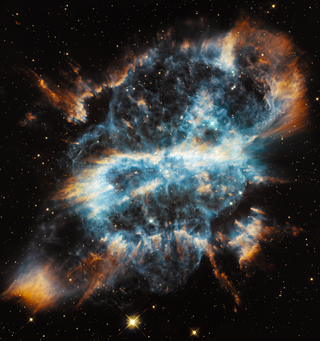
NGC 5189 is a planetary nebula in the constellation Musca. It was discovered by James Dunlop on 1 July 1826, who catalogued it as Δ252. For many years, well into the 1960s, it was thought to be a bright emission nebula. It was Karl Gordon Henize in 1967 who first described NGC 5189 as quasi-planetary based on its spectral emissions.

A protoplanetary nebula or preplanetary nebula is an astronomical object which is at the short-lived episode during a star's rapid evolution between the late asymptotic giant branch (LAGB)[a] phase and the subsequent planetary nebula (PN) phase. A PPN emits strongly in infrared radiation, and is a kind of reflection nebula. It is the second-from-the-last high-luminosity evolution phase in the life cycle of intermediate-mass stars.
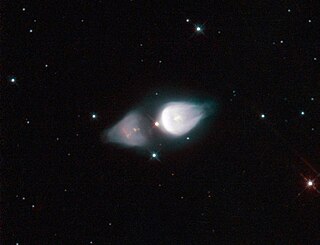
M1-92, also known as Minkowski’s Footprint or the Footprint Nebula, is a bipolar protoplanetary nebula in the constellation of Cygnus. It is a type of reflection nebula, visible only by light reflected from the central star. The central star is not yet a white dwarf but is quickly becoming one. In a few thousand years the star will be hot enough to emit vast quantities of ultraviolet radiation that will ionize the nebula surrounding it, making it a fully fledged planetary nebula.

The Red Rectangle Nebula, so called because of its red color and unique rectangular shape, is a protoplanetary nebula in the Monoceros constellation. Also known as HD 44179, the nebula was discovered in 1973 during a rocket flight associated with the AFCRL Infrared Sky Survey called Hi Star. The binary system at the center of the nebula was first discovered by Robert Grant Aitken in 1915.

NGC 6751, also known as the Glowing Eye Nebula, is a planetary nebula in the constellation Aquila. It is estimated to be about 6,500 light-years away.
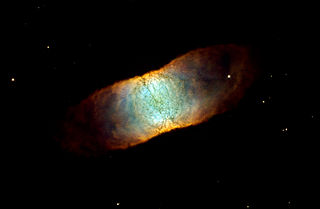
IC 4406, sometimes known as the Retina Nebula, is a planetary nebula near the western border of the constellation Lupus, the Wolf. It has dust clouds and has the shape of a torus. Despite this, it looks somewhat rectangular because it is seen from its side as viewed from Earth, almost in the plane of its equator.

A bipolar nebula is a type of nebula characterized by two lobes either side of a central star. About 10-20% of planetary nebulae are bipolar.

The Frosty Leo Nebula is a protoplanetary nebula (PPN) located roughly at 3000 light-years away from Earth in the direction of the constellation Leo. It is a spectral bipolar nebula. Its central star is of optical spectral type K7II, by itself called Frosty Leo. It is unusual in that it has an extremely deep absorption feature at 3.1 μm and is unusually located at more than 900 pc above the plane of our galaxy.(Bourke et al. 2000) Further, as of 1990, it has the only known PPN circumstellar outflow in which crystalline ice dominates the long-wavelength emission spectrum and the only known PPN with point-reflection-symmetric deviations from axial symmetry.

The Soap Bubble Nebula is a planetary nebula in the constellation Cygnus, near the Crescent Nebula. The nebula derives its name from its symmetrical spherical shape which resembles a soap bubble.
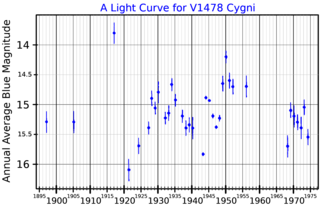
MWC 349 is a double star system in the constellation Cygnus. Its properties are still debated and it may be a massive highly luminous star or a very young less luminous Herbig Ae/Be star. MWC 349 is also a variable star with the designation V1478 Cygni.

Sh2-106, also known as the Celestial Snow Angel, is an emission nebula and a star formation region in the constellation Cygnus. It is a H II region estimated to be around 2,000 ly from Earth, in an isolated area of the Milky Way
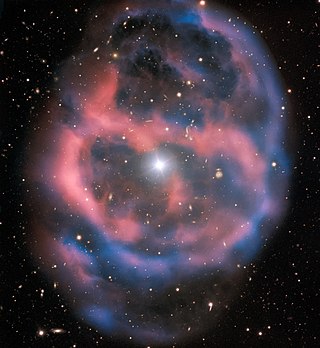
Abell 36 is a faint barrel shaped planetary nebula located 780 light years from Earth in the constellation of Virgo. It was discovered by the American astronomer George Ogden Abell in 1955.



















